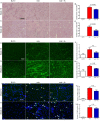Molecular hydrogen alleviates motor deficits and muscle degeneration in mdx mice
- PMID: 26866650
- PMCID: PMC6837388
- DOI: 10.1080/13510002.2015.1135580
Molecular hydrogen alleviates motor deficits and muscle degeneration in mdx mice
Abstract
Objective: Duchenne muscular dystrophy (DMD) is a devastating muscle disease caused by a mutation in DMD encoding dystrophin. Oxidative stress accounts for dystrophic muscle pathologies in DMD. We examined the effects of molecular hydrogen in mdx mice, a model animal for DMD.
Methods: The pregnant mother started to take supersaturated hydrogen water (>5 ppm) ad libitum from E15.5 up to weaning of the offspring. The mdx mice took supersaturated hydrogen water from weaning until age 10 or 24 weeks when they were sacrificed.
Results: Hydrogen water prevented abnormal body mass gain that is commonly observed in mdx mice. Hydrogen improved the spontaneous running distance that was estimated by a counter-equipped running-wheel, and extended the duration on the rota-rod. Plasma creatine kinase activities were decreased by hydrogen at ages 10 and 24 weeks. Hydrogen also decreased the number of central nuclei of muscle fibers at ages 10 and 24 weeks, and immunostaining for nitrotyrosine in gastrocnemius muscle at age 24 weeks. Additionally, hydrogen tended to increase protein expressions of antioxidant glutathione peroxidase 1, as well as anti-apoptotic Bcl-2, in skeletal muscle at age 10 weeks.
Discussion: Although molecular mechanisms of the diverse effects of hydrogen remain to be elucidated, hydrogen potentially improves muscular dystrophy in DMD patients.
Keywords: Duchenne muscular dystrophy; Molecular hydrogen; Muscle degeneration; Oxidative stress; mdx mouse.
Conflict of interest statement
Figures





Similar articles
-
Pre-clinical evaluation of N-acetylcysteine reveals side effects in the mdx mouse model of Duchenne muscular dystrophy.J Physiol. 2017 Dec 1;595(23):7093-7107. doi: 10.1113/JP274229. Epub 2017 Sep 30. J Physiol. 2017. PMID: 28887840 Free PMC article.
-
GYY4137, a Slow-Releasing Hydrogen Sulfide Donor, Attenuates Skeletal Muscle Abnormalities in a Murine Model of Duchenne Muscular Dystrophy.Antioxid Redox Signal. 2025 Jul;43(1-3):115-137. doi: 10.1089/ars.2024.0702. Epub 2025 Jun 5. Antioxid Redox Signal. 2025. PMID: 40476490
-
Aminoguanidine hemisulfate improves mitochondrial autophagy, oxidative stress, and muscle force in Duchenne muscular dystrophy via the AKT/FOXO1 pathway in mdx mice.Skelet Muscle. 2025 Jan 13;15(1):2. doi: 10.1186/s13395-024-00371-1. Skelet Muscle. 2025. PMID: 39806512 Free PMC article.
-
Brain function in Duchenne muscular dystrophy.Brain. 2002 Jan;125(Pt 1):4-13. doi: 10.1093/brain/awf012. Brain. 2002. PMID: 11834588 Review.
-
Bone tissue and muscle dystrophin deficiency in mdx mice.Joint Bone Spine. 2012 Mar;79(2):129-33. doi: 10.1016/j.jbspin.2011.08.004. Epub 2011 Nov 12. Joint Bone Spine. 2012. PMID: 22079415 Review.
Cited by
-
Effects of carbohydrate-electrolyte dissolved alkaline electrolyzed water on physiological responses during exercise under heat stress in physically active men.Curr Res Physiol. 2022 Sep 22;5:389-398. doi: 10.1016/j.crphys.2022.09.007. eCollection 2022. Curr Res Physiol. 2022. PMID: 36193515 Free PMC article.
-
Hydrogen: A Novel Option in Human Disease Treatment.Oxid Med Cell Longev. 2020 Sep 5;2020:8384742. doi: 10.1155/2020/8384742. eCollection 2020. Oxid Med Cell Longev. 2020. PMID: 32963703 Free PMC article. Review.
-
Hydrogen water alleviates obliterative airway disease in mice.Gen Thorac Cardiovasc Surg. 2020 Feb;68(2):158-163. doi: 10.1007/s11748-019-01195-3. Epub 2019 Aug 29. Gen Thorac Cardiovasc Surg. 2020. PMID: 31468277
-
Case Report: Acute hydrotherapy with super-saturated hydrogen-rich water for ankle sprain in a professional athlete.F1000Res. 2020 Apr 8;9:245. doi: 10.12688/f1000research.22850.1. eCollection 2020. F1000Res. 2020. PMID: 32399209 Free PMC article.
-
Hydrogen-rich water suppresses the reduction in blood total antioxidant capacity induced by 3 consecutive days of severe exercise in physically active males.Med Gas Res. 2020 Jan-Mar;10(1):21-26. doi: 10.4103/2045-9912.279979. Med Gas Res. 2020. PMID: 32189665 Free PMC article.
References
MeSH terms
Substances
LinkOut - more resources
Full Text Sources
Other Literature Sources
